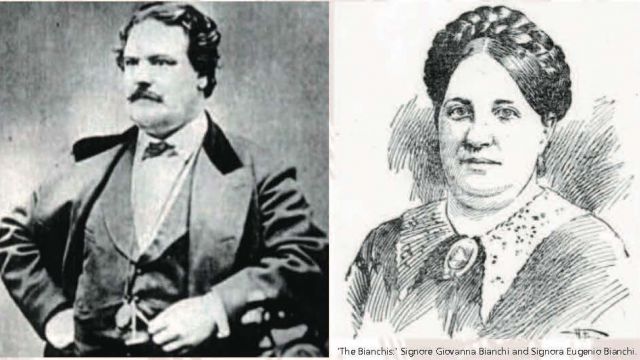Grand Opera, Grand Drama
What stories can an old theatre programme tell? Plenty according to Susan Mills, an archivist with the Seaborn, Broughton & Walford Foundation. She turns the page back to 1860 and the performance of Il Trovatore at the doomed Prince of Wales Theatre.
Every theatre programme has a story behind it, with often as much drama behind the scenes as on stage. Let’s take a look at the oldest programme in the S,B&W archive for the performance of Il Trovatore which opened at the Prince of Wales Theatre in Sydney on the 29th of May, 1860.
For one shilling this souvenir program containing the Italian and English words to Verdi's Il Trovatore could be purchased. It was published at the ‘Caxton’ printing office in George Street, Sydney.
The Prince of Wales Theatre, on the corner of Sydney’s Castlereagh and King streets, had been opened by former haberdasher Joseph Wyatt in 1855.
In 1859, Samuel Colville was the new lessee and manager of the Prince of Wales Theatre, and he sought to put on an unprecedented and ambitious season of Italian opera.

On the 18th of June 1859 a ‘Preliminary Announcement’ was printed in the Sydney Morning Herald urging readers to join the subscription list for ‘OPERA UPON A GRAND SCALE’.
Signora and Signor Bianchi (Giovanna and Eugenio Bianchi) were to be the stars. The pair were Italian born and trained, including having studied under Puccini, and had just wowed America, so were billed as being ‘from California’.
Arriving in Melbourne in late December of 1859, their performances at the Theatre Royal had been much praised, before they embarked on a tour of the Victorian goldfields as the Italian Opera Company.
When the Bianchis arrived in Sydney in early May of 1860 the newspapers were abuzz, hoping that it would be a step towards the “anxious expectation” of Sydney theatre-goers for “the establishment of an operatic company”.
They were quickly engaged by the Prince of Wales Theatre’s Mr Colville for a Grand Operatic Season.
 On the 16th of May 1860, it was advertised in Empire that Mr Colville had, “at very great expense”, secured the Bianchis for a six-opera season “in a style of grandeur never before attempted in Australia”. Signor Cesare Cutolo, a pianist originally from Naples, was to be the conductor.
On the 16th of May 1860, it was advertised in Empire that Mr Colville had, “at very great expense”, secured the Bianchis for a six-opera season “in a style of grandeur never before attempted in Australia”. Signor Cesare Cutolo, a pianist originally from Naples, was to be the conductor.
The preparations for the one-month season of Il Trovatore, Lucrezia Borgia, Ernani, Nabucco, Norma, and La Traviata were fraught.
On 22nd of May 1860, a published letter by Signor Cesare Cutolo sparked a very public war of words in the newspapers between the conductor and seemingly everyone else.
It culminated in a protest published by the opera company members against Sig. Cutolo, whom they felt was “from inexperience, unable to wield the baton as conductor”. In the end, the performances were conducted by Mons. Jacques Paltzer.
The price of admission also caused a small stir, being somewhat higher than usual (running from 1 shilling for a gallery spot, to £3 to £4 for a dress circle box), due to the large expenses of the season.
At the first preview, The Sydney Morning Herald reported that many seats remained “disengaged” and assured the public not to be deterred by fears of overcrowding on opening night.
The free list had been suspended (apart from the press) and ‘Children in arms’ were not to be admitted. Sydney was also at the start of the influenza epidemic of 1860-61.
However, the following day the Sydney Morning Herald reported that the theatre was “crowded in every part”, with applause by the enthusiastic audience which “literally overwhelmed the opera with demonstrations of satisfaction”. The singing and acting of the Bianchis and the company, the music, and the settings and costumes, and the whole spectacle, were all roundly praised.
A few months after this season of grand opera, the Prince of Wales Theatre would burn down. It reopened with the same name, run by R. Fitzgerald, until it again burned down in 1872.
Like a phoenix rising from the ashes, a theatre again arose on this spot, run by Sam Lazar, who instead choose a different name – the Theatre Royal. Another fire in 1892 resulted in a remodeling, and the theatre ran until 1972, when it was felled, this time by ‘progress’.
Developers tore down the theatre and opened the MLC Centre on this spot, but the public outcry was loud and they were persuaded to add a theatre into the design – again the Theatre Royal. More recently, in 2016, this spot was in danger of being theatre-less but again the public outcry resulted in an upgraded Theatre Royal opening in 2021.
Signor and Signora Bianchi's Grand Italian Opera Company went on to tour around New South Wales, Victoria and South Australia in 1860 and 1861. More drama followed - Eugenio Bianchi sued a South Australian newspaper for libel for claiming the company name was false advertising with only two Italians. The Bianchis left Australia for San Fransisco in January 1862, having given Australia a taste of grand beauty and drama. All that remains is a printed program.

